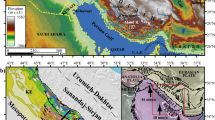Abstract
A brief introduction to catastrophe theory is presented, within the context of geological application, and a fundamental problem with a critical axiom of the theory noted. Implications for the application of this theory to modeling geological processes are noted and a solution to the problem proposed. The new approach is examined with reference to a model for sediment transport on the continental slope.
Similar content being viewed by others
References
Broeker, T., and Lander, L., 1975, Differential germs and catastrophes: London Mathematical Society Lecture Note Series 17, Cambridge Univ. Press, 179 p.
Hawkins, D. M., and Merriam, D. F., 1974, Zonation of multivariate sequences of digitized geological data: Jour. Math. Geology, v. 6, no. 3, p. 263–269.
Hawkins, D. M., and Merriam, D. F., 1975, Segmentation of discrete sequences of geologic data: Geol. Soc. America Mem. 142, p. 311–315.
Henley, S., 1976, The identification of discontinuities from areally distributed data,in Quantitative techniques for the analysis of sediments: Pergamon Press, Oxford, p. 157–168.
Isnard, C. A., and Zeeman, E. C., 1974, Some models from catastrophe theory in the social sciences,in Use of models in the social sciences: Tavistock Press, London, 238 p.
Thom, R., 1969, Topological models in biology: Topology, v. 8, p. 313–335.
Thom, R., 1972, Stabilité structurelle et morphogénèse: Benjamin, New York, 362 p.
Thompson, J. M. T., 1975, Experiments in catastrophe: Nature, v. 254, no. 5499, p. 392–395.
Thompson, J. M. T., and Hunt, G. W., 1973, A general theory of elastic stability. John Wiley & Sons, London, 322 p.
Thompson, J. M. T., and Shorrock, P. A., 1975, Bifurcational instability of an atomic lattice: Jour. Mech. Phys. Solids, v. 23, no. 1, p. 21–37.
Woodcock, A. E. R., and Poston, T., 1974, A geometric study of the elementary catastrophes: Lecture notes in mathematics, v. 373, Springer-Verlag, Berlin, 257 p.
Zeeman, E. C., 1971, The geometry of catastrophe: Times Literary Supplement, Dec. 10, 1971, p. 1556–1557.
Zeeman, E. C., 1972, Differential equations for the heartbeat and nerve impulse,in Towards a theoretical biology, v. 4: Edinburgh Univ. Press, Edinburgh, p. 8–67.
Zeeman, E. C., 1976, Catastrophe theory: Scientific American, v. 234, no. 4, p. 65–83.
Author information
Authors and Affiliations
Rights and permissions
About this article
Cite this article
Cubitt, J.M., Shaw, B. The geological implications of steady-state mechanisms in catastrophe theory. Mathematical Geology 8, 657–662 (1976). https://doi.org/10.1007/BF01031096
Received:
Issue Date:
DOI: https://doi.org/10.1007/BF01031096




